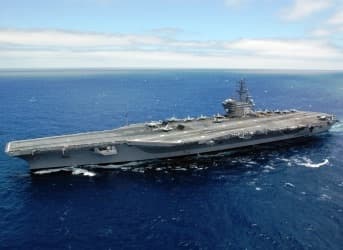On 12 March 2011 the six-reactor Fukushima Daiichi complex, owned by Tokyo Electric Power Company, Inc., approximately 150 miles north of Tokyo, was effectively destroyed by a tsunami that followed an offshore 9.0 Richter scale earthquake. The same day, U.S. Ambassador to Japan John V. Roos declared a disaster due to the effects of the earthquake and tsunami. In response, the USAID activated a Response Management Team in Washington, D.C., and deployed a Disaster Assistance Response Team to Japan to coordinate U.S. government response efforts in Japan. On 13 March, the two urban search and rescue teams arrived in Japan as part of the DART.
Following a request for help from the Japanese government, the USS Ronald Reagan (CVN-76) a Nimitz-class nuclear-powered 101,400-ton carrier and its strike group, en route to South Korea, where it was scheduled to participate in a joint South Korean-U.S. military exercise the following week and operating at sea about 100 miles northeast of the NPP, changed course and arrived off the stricken facility the next day to participate in relief operations. In all, 24 U.S. Navy ships, 189 aircraft and 24,000 service personnel were deployed to help Japan in Operation Tomodachi.
By the end of the day the USS Ronald Reagan had conducted six maritime search and rescue missions and 20 helicopter missions to deliver supplies to ships at sea and three towns near Sendai.
But then, after four days the U.S. 7th Fleet temporarily repositioned its ships and aircraft away from downwind from the Fukushima Daiichi NPP after detecting low level contamination in the air and on its aircraft operating in the area. A Navy press release at the time said, “For perspective, the maximum potential radiation dose received by any ship’s force personnel aboard the ship when it passed through the area was less than the radiation exposure received from about one month of exposure to natural background radiation from sources such as rocks, soil, and the sun.”
Related article: This Unpronounceable Name Could Unlock a Major Uranium Prize
But on 15 March, the U.S. Navy said very low levels of airborne radiation were detected at greater Tokyo-area U.S. military bases in Yokosuka and Atsugi, prompting commanders to direct base residents to remain indoors as a precaution. That morning the USS George Washington (CVN-763 Nimitz-class aircraft carrier stationed at Yokosuka Naval Base detected elevated radiation levels, according to a U.S. Navy 7th Fleet announcement, which stated that the elevated radiation levels emanated from the damaged Fukushima Daiichi NPP.
Fast forward two years.
In June 2013 a mass tort lawsuit filed in San Diego by plaintiff lawyer Paul Garner and co-counsel Charles Bonner, contends that the 71 plaintiff sailors’ health was injured by radiation emitted by the Fukushima Daiichi NPP. Garner said, "They're suffering from the whole Chernobyl panoply," adding that many plaintiffs, most in their 20s, have been diagnosed with "cancers, leukaemias, bleeding from vagina and rectum, abnormal growths, loss of eyesight, migraine headaches, weight gain/loss, immuno-deficiencies, loss of strength, mobility" and other ailments. An amended suit with around 100 USS Ronald Reagan sailor plaintiffs is due to be filed again in February. Garner contends that TEPCO knew that 400 tons of radioactivity was leaking into the sea each day and cites the USS Ronald Reagan's deck logs to assert that the ship spent five hours sailing through a plume of radioactive material, after steam was vented from the NPP to preclude a lethal chain reaction.
Not surprisingly, TEPCO denies liability.
Senior Chief Michael Sebourn, a radiation-decontamination officer on board the aircraft carrier USS Ronald Reagan, assigned to test the aircraft carrier following its deployment, said that radiation levels measured 300 times higher than what was considered safe at one point.
Related article: U.S. Desire for Short Term Profit could Lead to Nuclear Power Implosion
Sebourn also tested aircraft at Misawa Air Base, 200 miles from Fukushima. Sebourn subsequently suffered health issues as well, suffering nose bleeds, headaches and nausea in the immediate aftermath, symptoms consistent with radiation poisoning and along atrophy in his right arm and said, “I have issues that can’t be explained. It just seems like I am deteriorating.” Ironically, the USS Ronald Reagan has a multimillion-dollar radiation-detection system, but the crew couldn’t get it activated quickly enough.
Co-counsel Charles Bonner observed of TEPCO, “their second largest office outside of Tokyo is in Washington, D.C. This foreign corporation caused harm to American rescuers, and they did it in ways that give rise to jurisdiction here in this country.”
Two things are certain – the lawsuit has the potential to create great discomfort for both Tokyo and Washington, and that the USS Ronald Reagan’s ill sailors little dreamed that when they joined the U.S. Navy in order to put themselves “in harm’s way” for their country, that it would include battling life-threatening illnesses likely caused by an industrial accident in an allied county. It will be interesting next month to see if the lawsuit proceeds or is dismissed on a technicality.
We’ll leave the final word to Stars and Stripes, the newspaper authorized by Congress and the U.S. Department of Defense to produce independent daily military news and information distributed at U.S. foreign military installations, “The U.S. military has refused requests from Stars and Stripes for detailed information about the types of toxins and the levels that personnel were exposed to during Operation Tomodachi.”
By. John C.K. Daly of Oilprice.com



















Check out the January 3rd section of this blog.
http://www.hiroshimasyndrome.com/fukushima-commentary.html
Energy is too important to be hijacked by wild-eyed crazies.